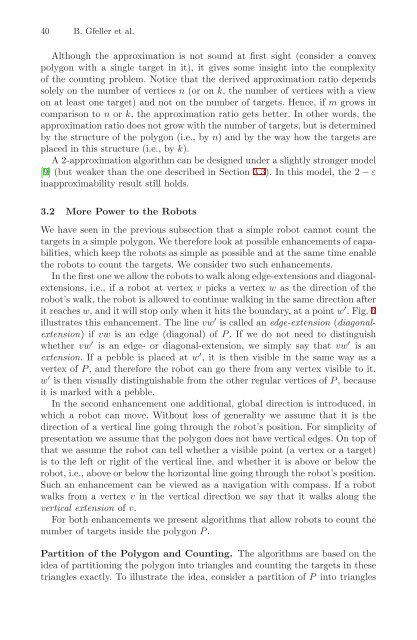Lecture Notes in Computer Science 4837
Lecture Notes in Computer Science 4837
Lecture Notes in Computer Science 4837
You also want an ePaper? Increase the reach of your titles
YUMPU automatically turns print PDFs into web optimized ePapers that Google loves.
40 B. Gfeller et al.<br />
Although the approximation is not sound at first sight (consider a convex<br />
polygon with a s<strong>in</strong>gle target <strong>in</strong> it), it gives some <strong>in</strong>sight <strong>in</strong>to the complexity<br />
of the count<strong>in</strong>g problem. Notice that the derived approximation ratio depends<br />
solely on the number of vertices n (or on k, the number of vertices with a view<br />
on at least one target) and not on the number of targets. Hence, if m grows <strong>in</strong><br />
comparison to n or k, the approximation ratio gets better. In other words, the<br />
approximation ratio does not grow with the number of targets, but is determ<strong>in</strong>ed<br />
by the structure of the polygon (i.e., by n) and by the way how the targets are<br />
placed <strong>in</strong> this structure (i.e., by k).<br />
A 2-approximation algorithm can be designed under a slightly stronger model<br />
[9] (but weaker than the one described <strong>in</strong> Section 3.3). In this model, the 2 − ε<br />
<strong>in</strong>approximability result still holds.<br />
3.2 More Power to the Robots<br />
We have seen <strong>in</strong> the previous subsection that a simple robot cannot count the<br />
targets <strong>in</strong> a simple polygon. We therefore look at possible enhancements of capabilities,<br />
which keep the robots as simple as possible and at the same time enable<br />
the robots to count the targets. We consider two such enhancements.<br />
In the first one we allow the robots to walk along edge-extensions and diagonalextensions,<br />
i.e., if a robot at vertex v picks a vertex w as the direction of the<br />
robot’s walk, the robot is allowed to cont<strong>in</strong>ue walk<strong>in</strong>g <strong>in</strong> the same direction after<br />
it reaches w, and it will stop only when it hits the boundary, at a po<strong>in</strong>t w ′ .Fig.6<br />
illustrates this enhancement. The l<strong>in</strong>e vw ′ is called an edge-extension (diagonalextension)<br />
ifvw is an edge (diagonal) of P . If we do not need to dist<strong>in</strong>guish<br />
whether vw ′ is an edge- or diagonal-extension, we simply say that vw ′ is an<br />
extension. If a pebble is placed at w ′ , it is then visible <strong>in</strong> the same way as a<br />
vertex of P , and therefore the robot can go there from any vertex visible to it.<br />
w ′ is then visually dist<strong>in</strong>guishable from the other regular vertices of P , because<br />
it is marked with a pebble.<br />
In the second enhancement one additional, global direction is <strong>in</strong>troduced, <strong>in</strong><br />
which a robot can move. Without loss of generality we assume that it is the<br />
direction of a vertical l<strong>in</strong>e go<strong>in</strong>g through the robot’s position. For simplicity of<br />
presentation we assume that the polygon does not have vertical edges. On top of<br />
that we assume the robot can tell whether a visible po<strong>in</strong>t (a vertex or a target)<br />
is to the left or right of the vertical l<strong>in</strong>e, and whether it is above or below the<br />
robot, i.e., above or below the horizontal l<strong>in</strong>e go<strong>in</strong>g through the robot’s position.<br />
Such an enhancement can be viewed as a navigation with compass. If a robot<br />
walks from a vertex v <strong>in</strong> the vertical direction we say that it walks along the<br />
vertical extension of v.<br />
For both enhancements we present algorithms that allow robots to count the<br />
number of targets <strong>in</strong>side the polygon P .<br />
Partition of the Polygon and Count<strong>in</strong>g. The algorithms are based on the<br />
idea of partition<strong>in</strong>g the polygon <strong>in</strong>to triangles and count<strong>in</strong>g the targets <strong>in</strong> these<br />
triangles exactly. To illustrate the idea, consider a partition of P <strong>in</strong>to triangles
















